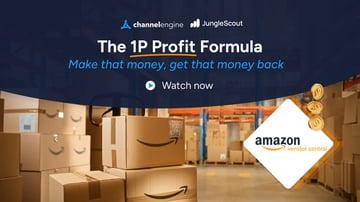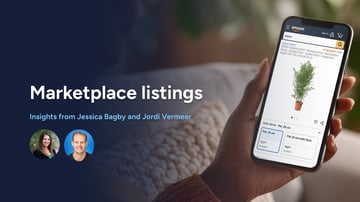In this live session, held on October 30, 2025, Hilary Smith from Jungle Scout joined Greg Alexandrian of AMZ PhD, Bobby Peloquin from ChannelEngine, and host Matt Tomaszewski to unpack the real levers 1P brands use to grow profit on Amazon.
The panel covered where to find category white space, how to convert visibility into efficient revenue, and how to recover dollars you have already earned but have not received.
Key Takeaways 💡
The discussion revealed a simple formula: Innovate to meet demand, make that demand find you efficiently, then protect every dollar with disciplined recovery. Brands that work these three levers in concert see faster growth and a healthier net PPM.
- Benchmark to your category, not yourself: If your category is growing and you are flat or down, you are losing share. Start by comparing revenue, units, and ASP trends against your category and core subcategories.
- Innovate into adjacent demand: White space hides in sub-subcategories and “next product” use cases. Track which adjacent segments are gaining revenue share, then launch where pricing power and growth intersect.
- Fix distribution and buy box leaks: 1P vendors still lose the buy box. Identify unauthorized 3P sellers, tighten compliance, and use Brand Registry to close the revenue leak.
- Run advertising that compounds SEO, not replaces it: Optimized product content lowers CPCs and improves ROAS. Use the right mix of Sponsored Products, Brands, and Display. Negative keywords matter.
- Aim for efficiency, then raise budgets: If ads are profitable at your target ACoS, increase budgets so you stop going dark mid-day. If budgets are capped, use day parting to reduce spend in low-efficiency hours.
- Recover lost dollars with a process, not a hope: Shortages, chargebacks, co-op fees, and price discrepancies add up. Many brands leave 1 to 5 percent of revenue on the table, sometimes more, because disputes are complex and time-bound.
🎥 Missed the live session?
Here's the recording:
Best Practices and Key Learnings
1. Innovation that follows real demand
- Validate demand, then build: Use category indexing to see if your revenue and unit growth are moving with or ahead of the category.
- Price with intent: Monitor ASP trends to gauge pricing power for new launches. Enter segments where you can sustain margin, not just velocity.
- Spot white space: Track new ASIN entrants and adjacent category growth.
Take the protein category, for example - what used to be all powders and shakes has now expanded into nuts, jerky, granola, premade drinks, and even candy. That’s the kind of data-backed innovation that wins.”
 Hilary Smith
Hilary SmithVP of Marketing
Checklist:
- Compare your 12-month revenue and unit growth to your top 3 subcategories.
- List the 5 fastest-growing adjacent sub-subcategories and their ASP ranges.
- Prioritize 2 launch candidates where demand, ASP, and brand fit align.
2. Visibility that turns into margin, not just clicks
- Content first: Strong titles, bullets, and A+ content make ads cheaper and convert better. SEO inputs feed ad efficiency.
- Right ad mix: Sponsored Products is the workhorse, with Sponsored Brands and Display for coverage. Balance manual and auto.
- Manage like a portfolio: Promote high net-PPM ASINs to lift your aggregate margin metrics. Also, use targeted ads to cure unhealthy inventory before Amazon markdowns kick in.
 Greg Alexandrian
Greg AlexandrianPresident & CEO
What “good” looks like
- Tight negative keyword lists and regular pruning.
- Clear separation between growth campaigns, margin-builder campaigns, and inventory-health campaigns.
- Budgets aligned to efficiency. When ACoS is on target, scale. When budgets are fixed, day part to avoid spending during weak hours.
3. Recovery management that protects profit you already earned
- Know the buckets: Shortages (units received vs shipped), chargebacks, co-op fees, price discrepancies.
- Expect effort: Disputes often require multiple submissions. Partial repayments are common, so keep going until fully resolved.
- Mind the clock: Lookback windows exist. For shortages, the historical window can be several years, but policies evolve, so act now rather than wait.
Real-world results mentioned
- A mid-market gaming brand doing roughly 30 to 35 million on Amazon uncovered about 2.7 million dollars in shortages and recovered 2.4 million.
- A smaller brand, around 1.2 million in sales, recovered roughly 100,000 dollars, which they reinvested into growth.
Most vendors don’t realize how much is left unclaimed in shortages and chargebacks, or how much time it takes to chase it. Automating that recovery turns lost revenue into fuel for innovation and advertising.
 Bobby Peloquin
Bobby PeloquinVendor Lead - North America
Recovery playbook
- Run a retro audit across all recoverable categories.
- Standardize evidence gathering for POs, ASNs, and invoices.
- Calendar follow-ups. If denied or partially paid, resubmit within the allowed limit.
- Track recovered funds as a budget line to fuel innovation or advertising.
4. Negotiation leverage through data and ads
- Lift net PPM deliberately: Drive incremental traffic to high net-PPM ASINs to raise the blended margin metric you bring into line reviews.
- Fix unhealthy inventory: Use targeted ads to create sell-through and remove the “profit drag” talking point in negotiations.
Final Thoughts
Winning 1P profit on Amazon is not about one silver bullet. It is about three compounders working together: Innovate where the demand is growing, get found efficiently, and keep every earned dollar. Do these consistently and negotiations get easier, budgets go further, and growth becomes repeatable.
Book a free consultation call with our marketplace experts to see how you can turn data into profit and recovery into growth.



